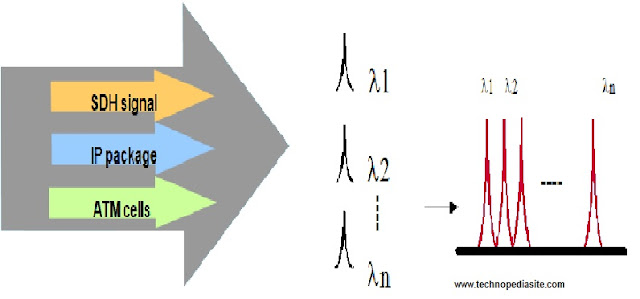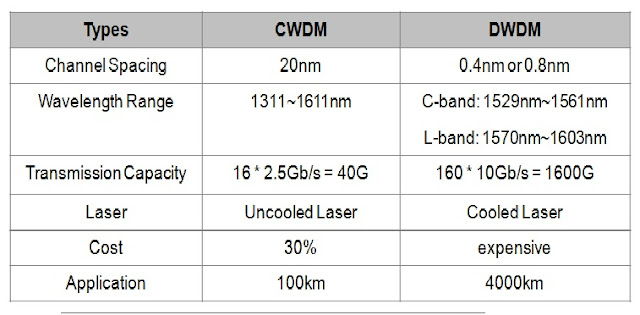Posted By: technopediasite
Development of DWDM
WDM (Wavelength-division Multiplexing) is the technology of combing a number of wavelengths onto the same fiber simultaneously. A powerful aspect of WDM is that each optical channel can carry any transmission format. WDW increases the capacity of a fiber network dramatically, thus recognized as the Layer 1 transport technology in all tiers of the network. The purpose of this article is to giver a brief overview of WDM technology and its applications.
1. Growth of voice, data, new services
2. Desire for information, communication
➤High rate TDM signal STM-1→STM-16→ STM-64
➤SDM-add fiber, equipment(time &cost)
transmission rates over farther distances are required. To meet these demands, network
managers are relying more and more on fiber optics. Typically, there are three methods for
expanding capacity: installing more cables, increasing system bitrate to multiplex more
signals and wavelength division multiplexing.

Development of DWDM
WDM (Wavelength-division Multiplexing) is the technology of combing a number of wavelengths onto the same fiber simultaneously. A powerful aspect of WDM is that each optical channel can carry any transmission format. WDW increases the capacity of a fiber network dramatically, thus recognized as the Layer 1 transport technology in all tiers of the network. The purpose of this article is to giver a brief overview of WDM technology and its applications.
1. Growth of voice, data, new services
2. Desire for information, communication
Developed rapidly :
4×2.5Gb/s→32×10Gb/s→1.6Tb/s
2. Developing trend: OADM, OXC…
4×2.5Gb/s→32×10Gb/s→1.6Tb/s
2. Developing trend: OADM, OXC…
How to increase network capacity?
➤WDM is a quick, economical and mature method.➤High rate TDM signal STM-1→STM-16→ STM-64
➤SDM-add fiber, equipment(time &cost)
Why We Need WDM?
Due to the rapid growth in telecommunication links, high capacity and faster datatransmission rates over farther distances are required. To meet these demands, network
managers are relying more and more on fiber optics. Typically, there are three methods for
expanding capacity: installing more cables, increasing system bitrate to multiplex more
signals and wavelength division multiplexing.
WDM has been proved more cost effective in many instances. It not only allows current electronics and current fibers, but also simply shares fibers by transmitting different channels at different wavelengths (colors) of light. Besides, systems are already using fiber optic amplifiers as repeaters also do not require upgrading for most WDM.

WDM Concept
Different signals with specific wavelength
are multiplexed into a fiber for transmission.
WDM Syetem Compositions
lThe overall structure of the WDM system of N-path wavelength:
lOptical wavelength transponder unit (OTU)
lOptical Multiplexer Unit / optical De-multiplexer Unit (OMU/ODU)
lOptical Amplifier (OA) Optical Supervisory Channel (OSC/ESC)
lOptical wavelength transponder unit (OTU)
lOptical Multiplexer Unit / optical De-multiplexer Unit (OMU/ODU)
lOptical Amplifier (OA) Optical Supervisory Channel (OSC/ESC)
Transmission modes – Unidirectional
transmission
lSingle fiber unidirectional transmission.
Transmission modes - Bi-directional
transmission
lSingle fiber
bi-directional transmission
Application modes - Open system
Open WDM system has no special requirements for multiplex terminal optical interfaces, the only requirement is that these interfaces meet the optical interface standards defined in ITU-T.
Application modes - Integrated system
Integrated WDM system does not adopt the wavelength conversion technology, instead, it requires that the wavelength of the optical signals at the multiplex terminal conforms to the specifications for the WDM system.
Actually, it is not difficult to understand the operating principle of WDM. Consider the fact that you can see many different colors of light: red, green, yellow, blue, etc. all at once. The colors are transmitted through the air together and may mix, but they can be easily separated using a simple device like a prism, just like we separate the “white” light from the sun into a spectrum of colors with the prism. WDM is equivalent to the prism in the operating principle. A WDM system uses a multiplexer at the transmitter to joint the several signals together, and a demultiplexer at the receiver to split them apart, as shown in following diagram. With the right type of fiber, it is possible to have a device that does both simultaneously, and can function as an optical add-drop multiplexer.
This technique was originally demonstrated with optical fiber in the early 80s. The first WDM systems combined only two signals. Modern systems can handle up to 160 signals and can thus expand a basic 10 Gbit/s system over a single fiber pair to over 1.6 Tbit/s. Because WDM systems can expand the capacity of the network and accommodate several generations of technology development in optical infrastructure without having to overhaul the backbone network, they are popular with telecommunications companies.
Advantages of DWDM
lTransparent media
lLong haul transmission
lHigh capacity
lUse existing optical fibers
lHigh performance-to-cost ratio
lReliability
lEasy upgrading
lLong haul transmission
lHigh capacity
lUse existing optical fibers
lHigh performance-to-cost ratio
lReliability
lEasy upgrading
Brief Introduction to CWDM
lCWDM (Coarse Wavelength Division Multiplex)
➤The CWDM greatly reduces the system cost while providing certain amount of wavelengths and transmission distance within 100 km.
lDifference between CWDM and DWDM:
➤The CWDM greatly reduces the system cost while providing certain amount of wavelengths and transmission distance within 100 km.
lDifference between CWDM and DWDM:
The channel spacings between individual wavelengths transmitted through the same fiber serve as the basis for defining CWDM and DWDM. Typically, spacing in CWDM systems is 20 nm, while most DWDM systems today offer 0.8 nm (100 GHz) wavelength separation according to the ITU standard. Due to wider CWDM channel spacing, the number of channels (lambdas) available on the same link is significantly reduced, but the optical interface components do not have to be as precise as DWDM components. CWDM equipment is thus significantly cheaper than DWDM equipment.
Due to the unique attributes of CWDM and DWDM, they are deployed for different transmission distances. Typically, CWDM can travel anywhere up to about 160 km. If we need to transmit the data over a very long range, DWDM system solution is the best choice for long-haul transport and large metro rings requiring high capacity. DWDM employs the 1550 wavelength band which can be amplified, enhancing transmission distance to hundreds of kilometers.











1 Comments
I have been meaning to write something like this on my website and you have given me an idea. hiperbolic
ReplyDelete